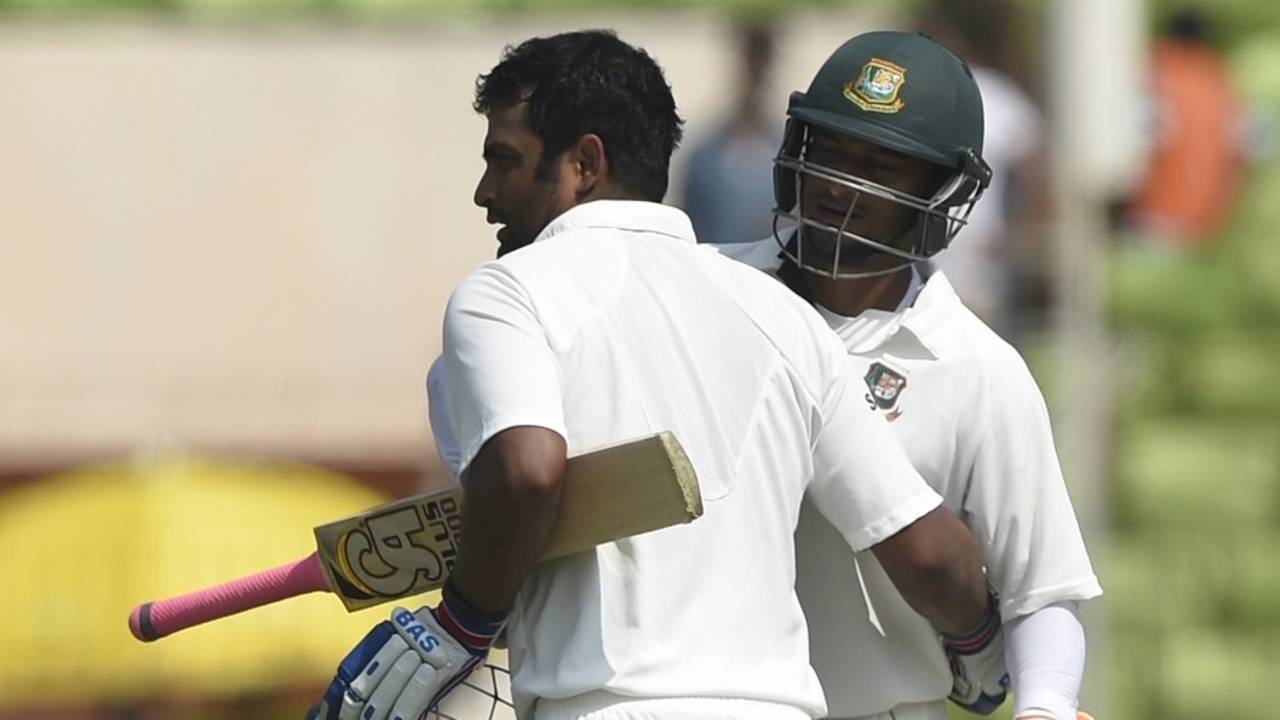Shakib and Tamim find harmony in diversity
Shakib Al Hasan's explosive approach was the perfect foil to Tamim Iqbal's patient game at the other end, as the pair batted Bangladesh to a strong position in Khulna
Devashish Fuloria in Khulna
04-Nov-2014
Tamim Iqbal and Shakib Al Hasan added 132 for the fourth wicket • AFP
Shakib Al Hasan and Tamim Iqbal have a number of similarities. Both are left-handed, both developed in age-group cricket, both started their international careers around the same time, both tasted early success and became national icons, both have played more or less the same number of Tests and have similar records in terms of runs scored, averages, and fifties. There is also not too much difference in the number of centuries they have scored.
Both players had been waiting a long time to increase their tally of Test hundreds. Tamim, for four years, and Shakib for more than three. Drought figures of that order would chew into a country's growth, so it's possible to make a connection on how Tamim and Shakib's respective dry periods could have been a cause of Bangladesh's stunted growth in Test cricket. The two should have done better given the amount of exposure they have had around the world but, if one is to look ahead, the two batsmen converting their starts to centuries could be the start of a regeneration process.
It was also a good sign for Bangladesh that the two batted together in contrasting styles despite their similarity in stats. They also bring other contrasts into the team: Shakib comes from Khulna, once the wild west of Bangladesh, and Tamim comes from the port city of Chittagong. Shakib joined a boarding school - the Bangladesh Krira Shikkha Protishtan - at an early age while Tamim grew up at home.
That contrast of styles, of early years, is a trait often visible in the most-successful partnerships: belligerence balanced with stability, the excitement countered with a dead-bat, the lofted shots complemented by ground strokes. It was the perfect recipe to grind down the opposition and still ensure the scoreboard kept moving at a quick pace.
That contrast of styles, of early years, is a trait often visible in the most-successful partnerships: belligerence balanced with stability, the excitement countered with a dead-bat, the lofted shots complemented by ground strokes. It was the perfect recipe to grind down the opposition and still ensure the scoreboard kept moving at a quick pace
On the first day, Bangladesh had been understandably slow; they wanted to bat long and not hand Zimbabwe bowlers the advantage. On the second morning, it would not have been surprising had Bangladesh continued in the same manner for at least the first session. But Tamim came with a fresh outlook and he got the innings moving with a couple of straight drives off the seamers, shots that were part of the method - playing straight - he was using since the first day but were played in quick succession early in the morning.
The excitement of the day, however, was generated by Shakib as he lofted the first ball from a spinner over the long-on boundary. Almost every time he left the crease to a spinner, Shakib aimed to hit over the top. There was no restraint on him. And with Zimbabwe feeding him with inexperienced spinners and part-timers in that crucial first session, he had no reason to hold himself back. Even as Brendan Taylor pushed men in the deep on the leg side, Shakib kept aiming for the gap at wide long-on.
It was during one of these attempts that he played probably the shot of the day. He stepped out to hit Natsai M'Shangwe towards that gap but realising the ball had been flighted too far outside off, he switched into a gorgeous Sangakkara-silky drive. Tamim could have been swayed into showing his repertoire of shots but he was rock solid in his discipline and hardly played a sweep shot in his entire innings. His on-drive through wide mid-on to reach his century was the perfect accompaniment of the hard-hitting action from Shakib's end.
When Shakib had walked in, Tamim had 69 against his name but by the time Tamim reached his fourth Test century, Shakib had already racked up 56. By the time Tamim left, the team score had swelled past 300 and the partnership had been worth 132, of which 89 had come from Shakib.
It is remarkable that in the 32 Tests Tamim and Shakib have played together, it was only the fourth instance of them being in at the same time. It was also their first century stand in any form of the game.
As the relative fragility of their middle order again showed, Bangladesh need their big guns to fire consistently, in parallel and in their own styles. The success, as both players' remarkably subdued celebrations showed, will often feel the same.
Devashish Fuloria is a sub-editor at ESPNcricinfo
